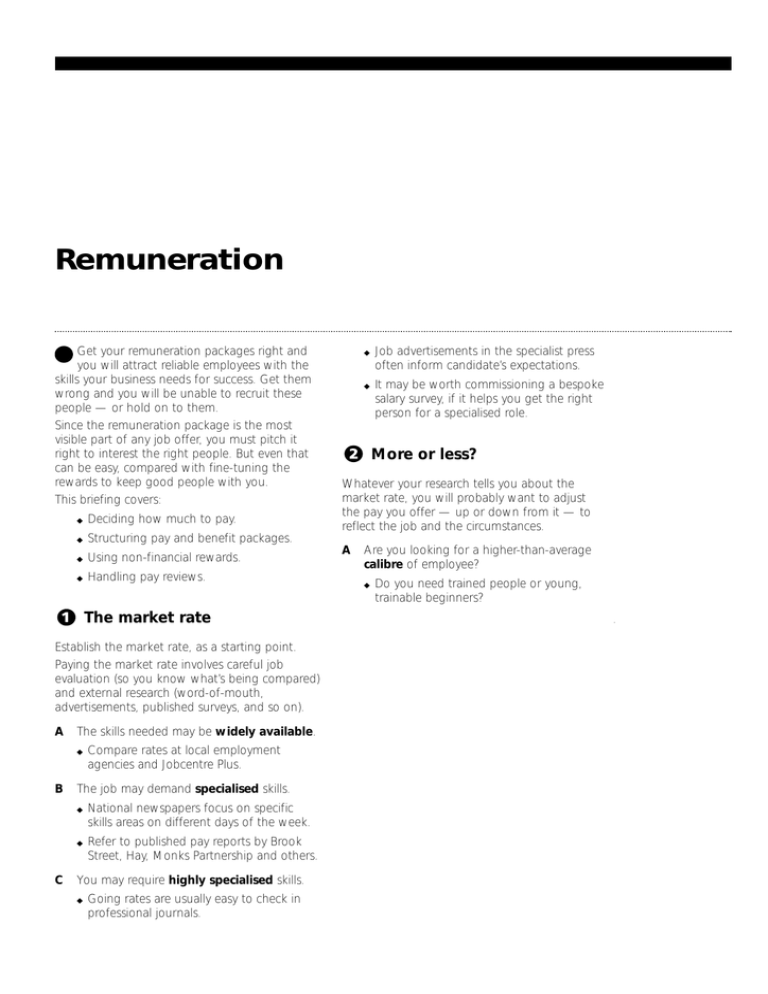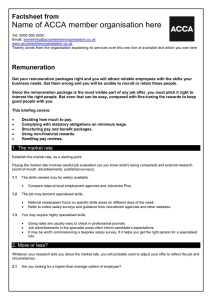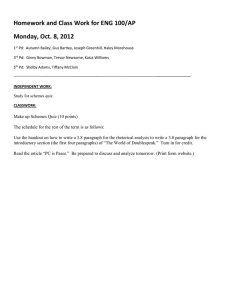Remuneration
advertisement

Remuneration Get your remuneration packages right and you will attract reliable employees with the skills your business needs for success. Get them wrong and you will be unable to recruit these people — or hold on to them. Since the remuneration package is the most visible part of any job offer, you must pitch it right to interest the right people. But even that can be easy, compared with fine-tuning the rewards to keep good people with you. This briefing covers: ◆ Deciding how much to pay. ◆ Structuring pay and benefit packages. ◆ Using non-financial rewards. ◆ Handling pay reviews. The market rate Establish the market rate, as a starting point. Paying the market rate involves careful job evaluation (so you know what’s being compared) and external research (word-of-mouth, advertisements, published surveys, and so on). A The skills needed may be widely available. ◆ B C Compare rates at local employment agencies and Jobcentre Plus. The job may demand specialised skills. ◆ National newspapers focus on specific skills areas on different days of the week. ◆ Refer to published pay reports by Brook Street, Hay, Monks Partnership and others. You may require highly specialised skills. ◆ Going rates are usually easy to check in professional journals. ◆ Job advertisements in the specialist press often inform candidate’s expectations. ◆ It may be worth commissioning a bespoke salary survey, if it helps you get the right person for a specialised role. More or less? Whatever your research tells you about the market rate, you will probably want to adjust the pay you offer — up or down from it — to reflect the job and the circumstances. A Are you looking for a higher-than-average calibre of employee? ◆ Do you need trained people or young, trainable beginners? B C What are the particular problems you face in recruiting the right people? ◆ Are there geographical factors (eg travel to central London, or a remote location)? ◆ Are the skills you need wanted urgently or in especially short supply? A Will you pay by time or performance? There are several possible approaches. Must you offer relocation allowances to attract good people from outside the area? ◆ The choice between wages and salaries is often a matter of tradition or expectations. Weekly wages suit companies with a fixed working day, short working hours or irregular patterns of work. ◆ Hourly pay may lead to high overtime costs if demand is irregular. ◆ Annual hours contracts can offer flexibility for both you and your employees, while avoiding premium payments for overtime. ◆ Piece rates link pay directly to productivity. ◆ Commission can be anything from the icing on the cake to the main element in the pay packet (see 4). Basic pay The most basic level of pay is set by law, with the national minimum wage fixed at £4.50 an hour, rising to £4.85 proposed from 1 October 2004 (see Working time and the minimum wage, HR 25). Above that, you can decide what and how you pay your employees. B Getting what you want Pay has to be related to your need. When recruiting, do not pay too much for unrealised potential (see Graduate recruitment, HR 14). A Recognise the distinction between skills and experience that are essential for your purposes and those that are desirable. B C ◆ Many skills can be developed on the job. ◆ Recognise that there are ‘unlearnable’ skills. For example, if you need someone fluent in French, you must recruit one. You will not be able to ‘grow your own’ within small business timescales. Focus on the qualities you need, bearing in mind that you are unlikely to find them all in one person. These may include: ◆ Reliability and attention to detail. ◆ Determination and drive. ◆ Flair and creativity. ◆ The aim is to create a situation where employees can feel their pay is reasonable, compared with each other. ◆ Part-timers and full-timers should be able to see how their pay is related. ◆ You must meet your legal obligations (eg to give equal pay for work of equal value). Make sure all decisions are free from discrimination — whether they are on the relative pay levels of existing staff, new employees’ pay or performance pay. ◆ Equal pay questionnaires allow employees to ask specific questions about pay levels — so you need to make sure you go by the book. Record all decisions and make sure they are supported by a robust process. ◆ Consider undertaking an equal pay review to identify any problematic areas and potential corrective measures. Assess people’s potential at an interview or appraisal (see Interviewing, HR 3, and Performance appraisals, HR 10). ◆ Reward emerging potential or employees will be tempted away. D Be realistic about your circumstances. E Your pay structure may be simple, but there should be some logic to it. Even without the grades, spines and pay curves found in big organisations, the shape of the overall structure should be clear. ◆ Only pay what you can afford. ◆ Sub-contract to get access to the skills you cannot afford in-house. ◆ Use non-cash incentives imaginatively. Be fair, and be seen to be fair, about pay. ◆ Research shows the smaller the ratio between the highest and lowest pay levels in a company, the better its commercial performance is likely to be. C Decide what part overtime is going to play — and how you are going to value it. D Be aware of tax and NI thresholds. Do not pay people amounts that will put them just above a threshold. ◆ E It may be possible to use tax-efficient incentives, rather than raising pay (see 5). Paying out cash as share dividends, rather than income, is still a tax-efficient way of remunerating shareholders — usually directors, investors and senior employees. ◆ Dividends attract income tax, but no NI. page 2 Bonuses and commission Bonuses and commission payments need to be seen by employees as extras, or there will be no incentive effect (see Incentive pay, HR 11). breaks, profit-related pay (paid to everyone at, say, ten per cent of salary) can be a powerful, non-divisive incentive. C A Incentives work, if the targets are right. B ◆ Incentive pay is only effective when it relates to specific achievements. ◆ It needs to be closely matched to the business and to the people involved. ◆ Incentives based on competition backfire if the same people always win. To get the desired results, you need to decide whose performance an incentive scheme should be based on. ◆ Incentives may be linked to performance at the company, team or individual level. The right linkage will depend on factors such as how much one person or group’s success depends on the efforts of others. ◆ Research shows many performance-related pay schemes give disappointing results, though this may often be due to poor targeting and unrealistic expectations. ◆ Profit-related pay is a type of performancerelated pay that automatically reflects a whole company’s achievements. The tax breaks that initially made these schemes attractive have now been scrapped. However, even without tax One for all ◆ B C Employers have to pay National Insurance, too (see 6). E Life assurance and death-in-service benefits are normally linked to pension schemes and are not usually liable to tax. ◆ Premiums paid for critical illness cover and income protection insurance are not taxed. Instead, the money paid out by such policies is taxed as income. Benefits like this can be bought much more cheaply through group schemes than by individual employees paying high premiums out of taxed income. ◆ Group schemes offer acceptance, up to certain limits, without medical questions. Commission is the usual basis of pay for sales operations. ◆ But low-basic, high-commission pay structures may not be the best way to motivate and retain people, as commission comes to be seen as income, not as an incentive. Using shares and options Share schemes and share option plans allow you to link long-term incentives to long-term goals. They give employees a stake in the company’s growth, making them hard to poach. A Shares and options granted under approved employee share schemes are free of income tax and NI, as long as they are held for the specified period. B Insurance cover helps employees guarantee their families some security. ◆ You will usually need to make bonuses between ten per cent and 25 per cent of salary to motivate employees effectively. D Other bonuses can be used to focus attention on whatever areas are important for the success of your business (eg a weekly productivity bonus or a 13th month’s pay to boost medium-term staff retention). A Membership of healthcare schemes is attractive. It is treated as a taxable benefitin-kind. The employee pays tax on it, and the employer must declare it on Form P11D. ◆ Performance bonuses need to be large enough to be significant to the individual. ◆ You may be able to offset the costs of setting up and funding such schemes against corporation tax. ◆ Approved schemes include Share Incentive Plans (formerly All-Employee Share Ownership Plans) and Enterprise Management Incentive schemes. Shares held by employees in the companies they work for now count as business assets for capital gains tax (CGT) purposes. ◆ C As long as they are held for more than one year, CGT is reduced. After two years, the maximum rate of CGT payable is ten per cent (for higher rate taxpayers). Unapproved schemes bring fewer tax breaks, but can be set up on a larger scale. D One brake on the progress of share plans in smaller companies is often the original owners’ concern about diluting their equity. ◆ You will also have to negotiate a market value of the shares with the Inland Revenue. page 3 Benefits NI is payable on all taxable benefits-in-kind. If there is tax on a benefit, the employer has to pay NI at 12.8 per cent in 2003/04. A Pensions are usually the first major benefit provided for employees (see Company pension schemes, HR 7, and Stakeholder pensions, HR 33). Contributions are treated favourably, with no tax or NI to pay on Inland Revenueapproved schemes. B Cars and car parking are still high on the list of benefits that employees find attractive. ◆ ◆ Though the tax advantages of having a company car have been whittled down, most people still accept a car, if offered. Employees are usually prepared to pay the tax on the benefit, because they are saved the hassles of buying and selling vehicles and budgeting for servicing and repairs. ◆ Always analyse the full costs and benefits of all the perks you offer. Non-financial extras Money is not the only thing people want from their jobs — and not the only motivator. A Use holidays creatively, as part of the employment package. ◆ Flexitime working can be a powerful attraction for potential recruits. C Job content and fulfilment are what many people want most from their work. A parking space at or near the place of work can be a valuable tax-free benefit. There is no tax to pay on mobile phones provided by an employer. ◆ If employees have part of their home phone bills reimbursed, including some private call costs, they will have to pay tax. It may be better to provide mobiles. ◆ Most employees want to be extended (‘stretched’), but not stressed. ◆ Use appraisals to fine-tune the role and get the best out of the person. ◆ The feeling of doing something worthwhile, for a worthwhile organisation, is a strong motivator for many people. D Training is particularly attractive to young, ambitious employees. D Living accommodation can be tax free for those who have to live in a certain place to do the job (eg caretakers and oil rig crews). ◆ Experience in a new role enhances a person’s CV and earning potential. ◆ Training makes the person more valuable to you, but also to any other employer. Elsewhere, it is taxed as a benefit. But even with the tax charge, potential recruits may find the offer of accommodation attractive. E Agreeing to extra unpaid leave may provide a trade-off if you cannot afford full market rates for specialist skills. B See Company cars and tax, TA 4. C Annual parties (or similar celebrations) paid for by the employer are tax free, up to a cost of £150 a head. Pay reviews There are several minor benefits that cost little to provide, are valued highly by employees and get favourable tax treatment. Pay reviews need to be regular and should be kept separate from performance reviews. ◆ Staff discounts (on your products) are not taxed and can be an attractive perk (eg in retailing, transport and travel). A Aim for a steady increase in real earnings, over the months and years, for employees whose performance is satisfactory. ◆ Free or subsidised meals are popular with employees and are not taxed as benefits provided they are made available to all employees and not a selected few. B Build in a performance-related element for every employee, including juniors. C Ask people what their needs are. ◆ ◆ Personal loans of up to £5,000 are not taxable and do not attract NI. Offering season ticket loans or interest-free loans to clear credit card debts can build loyalty. Long-service awards do not attract tax, providing the employee has worked for the business for 20 years. The value can be up to £50 for each year of service. ◆ A dissatisfied employee will not always be won over by a pay rise, even a large one. D Make a clear distinction between promotion and increases in pay for the job. E If there are trade unions in the workplace, involve them in reviewing the operation of your pay structure. page 4




